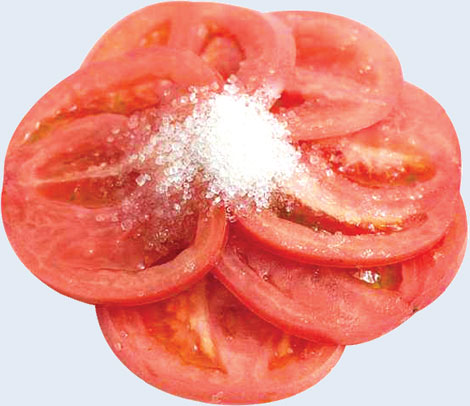Tomatoes in the Chinese kitchen
Editor's Note: Traditional and fusion cooking styles, regional and international ingredients and a new awareness of healthy eating are all factors contributing to an exciting time for Chinese cuisine. We explore the possibilities.
It belongs to a large group of plants of the nightshade family, but the tomato has been the most successfully adopted and adapted by Chinese chefs through the centuries.
Its cousins include potatoes, aubergines (eggplant) and bell peppers, all popular ingredients in China.

|
Tomatoes and those covered with powdered sugar (top). Photos Provided to China Daily |
No one can pinpoint the exact dates these vegetables were introduced to China, but the general consensus is that they came through the overland and maritime trade routes.
There is a chicken dish cooked by the Uygurs in the northwestern entry point of Xinjiang Uygur autonomous region that combines almost all of them. Known as "big pan chicken" or dapanji, it is a rich, tomato-based stew with chunks of potatoes, lots of onions and plenty of bell peppers.
That probably gives us a hint on the early beginnings.
Good ingredients are treasured by Chinese chefs who often go out of their comfort zones to seek them out. Foreign imports such as potatoes are now staples, and the chili pepper, too, has been naturalized.
The tomato's brilliant color and natural umami have made it another essential ingredient. In fact, the classic sweet and sour dishes of China now depend mainly on the tomato, where it used to be the haw fruit that colored and flavored in the past.
It used to be harvested only in summer, although it is now available all year round, thanks to bigger, better greenhouses and a countrywide logistics network that connects north to south and east to west.
In the early 1980s, as an exchange student in Beijing, I ate mainly tomatoes for three months in summer at the college canteen. If we had tomatoes on scrambled eggs for lunch, it was a sure bet that tomato egg drop soup would be served for dinner. The menu never varied.
On weekends, when the head cook was off duty, we had chilled sliced tomatoes covered with powdered sugar.
I later learned that the tomato dishes of that summer were not designed as a torturous initiation for unsuspecting foreign students. Everyone ate them, because vegetables were hard to come by, and every family had their own recipes.
In my husband's family, they cook down the tomatoes to a mush, flavored with lots of golden garlic and some fish sauce. Then the result is poured over barely cooked scrambled eggs.
Perhaps Westerners are more used to eating tomatoes in salads, dressed perhaps with a tart vinaigrette. That's the reason why sugar on sliced tomatoes took some getting used to. But it is surprisingly palatable.
It works better when you think of the tomato as a fruit, which it is, and not just as a vegetable.
The diversity of regional cooking styles and the rich pantry of ingredients now available to home chefs and professional cooks have not reduced the importance of the tomato in the kitchen.
It is used to stuff dumplings, pairing with such stronger-tasting meats like beef and lamb, and is cooked down to a sauce for hand-cut noodles. It is not only used to accompany noodles, but is actually worked into the noodles themselves, like spinach.
The love of tomato-flavored stews in northeastern China can also be traced to the Soviet influence of the past. For certain older generations, the only Western restaurants in the capital at that time served Russian food.
For them, Russian food meant a strongly tomato-flavored borscht, a hearty tomato and beef stew and minced-meat-stuffed cabbage rolls slowly stewed in a thick tomato sauce.
That was the pinnacle of gourmet eating in restaurants with names like Old Moscow, or Kiev.
Times have changed.
Modern Beijingers still love their tomatoes, but they are more likely to consume them as pizza sauce or over spaghetti. Modern chefs, many coming from overseas, have also introduced other new ways of eating tomatoes.
My 90-year-old mother-in-law loves her scrambled eggs and tomatoes, but she is also learning to enjoy the tomato soup I make, scattered with garlic croutons and scented with basil oil.
In Kunming in spring, we walk down to the village market to buy the cherry tomatoes that are just coming into season. They look like jewels, glowing red and gold and purple and orange. Every one is full of flavor, with a full spectrum ranging from sugary sweetness to mouth-puckering tartness.
Tomatoes can be enjoyed raw, but for optimum nutrition, they need a little oil to channel their vitamins in the body, and heat sweetens the berries and makes them even more tasty.
paulined@chinadaily.com.cn
Recipes
Tomato rice
10-12 tomatoes
1 small brown onion, diced
2 cups rice
1 tablespoon tomato paste
1 cup water
Salt and pepper
Turn each tomato over and cut a cross on the bottom. Drop into boiling water and blanch two minutes. Remove and cool tomatoes under running water. Peel off the skin.
Cut each tomato lengthwise and squeeze out the pulp and seeds. Dice the flesh finely.
Fry the diced onions till transparent and fragrant but not colored. Add the diced tomatoes and water and cook until very tender. Mix in the tomato paste, and season with salt and pepper.
Wash the rice and place in rice cooker. Add the tomato sauce and mix well. Press the button. After the button pops, use a spatula to mix the rice again before allowing it to rest.
Serve in individual bowls, or press into a ring mold and unmold over a large platter. You can serve a tasty stir-fry in the center for a colorful centerpiece.
Sweet and sour tomato fried fish
One whole fish, such as a small mackerel or pomfret (Or you can choose to use fish fillets)
4 tomatoes, quartered
1 onion, skinned and cut into thick slices
1 red bell pepper, sliced into strips 1 green bell pepper, sliced into strips
3-4 whole garlic cloves, skinned
Sauce:
1 tablespoon tomato paste or ketchup
1 tablespoon rice vinegar
1 tablespoon sugar
1 tablespoon cornstarch
1 cup water to combine the ingredients to make a slurry
Clean and pat the fish dry. Heat up oil in a frying pan and slowly fry the fish until golden brown. Set aside.
Pour off the fishy oil and add a spoonful of fresh oil. Fry the whole garlic gloves till golden brown. Add onion slices, followed by the tomatoes and bell pepper.
Keep the pan on high heat while stir-frying. That will keep the vegetables crisp, and not stew.
Combine sauces and water and stir well to mix the slurry.
Pour over the vegetable and quickly toss. Adjust seasoning with salt and pepper. Pour over the fried fish.
Chinese tomato salad
2-3 large fleshy tomatoes
Sugar and a pinch of salt
Slice off one end of each tomato and gently squeeze out excess liquid. Pat dry and cut into thick slices. Chill well.
Mix two spoonfuls of sugar with a pinch of salt. Sprinkle on the tomatoes just before serving.
(China Daily European Weekly 01/12/2018 page19)



















